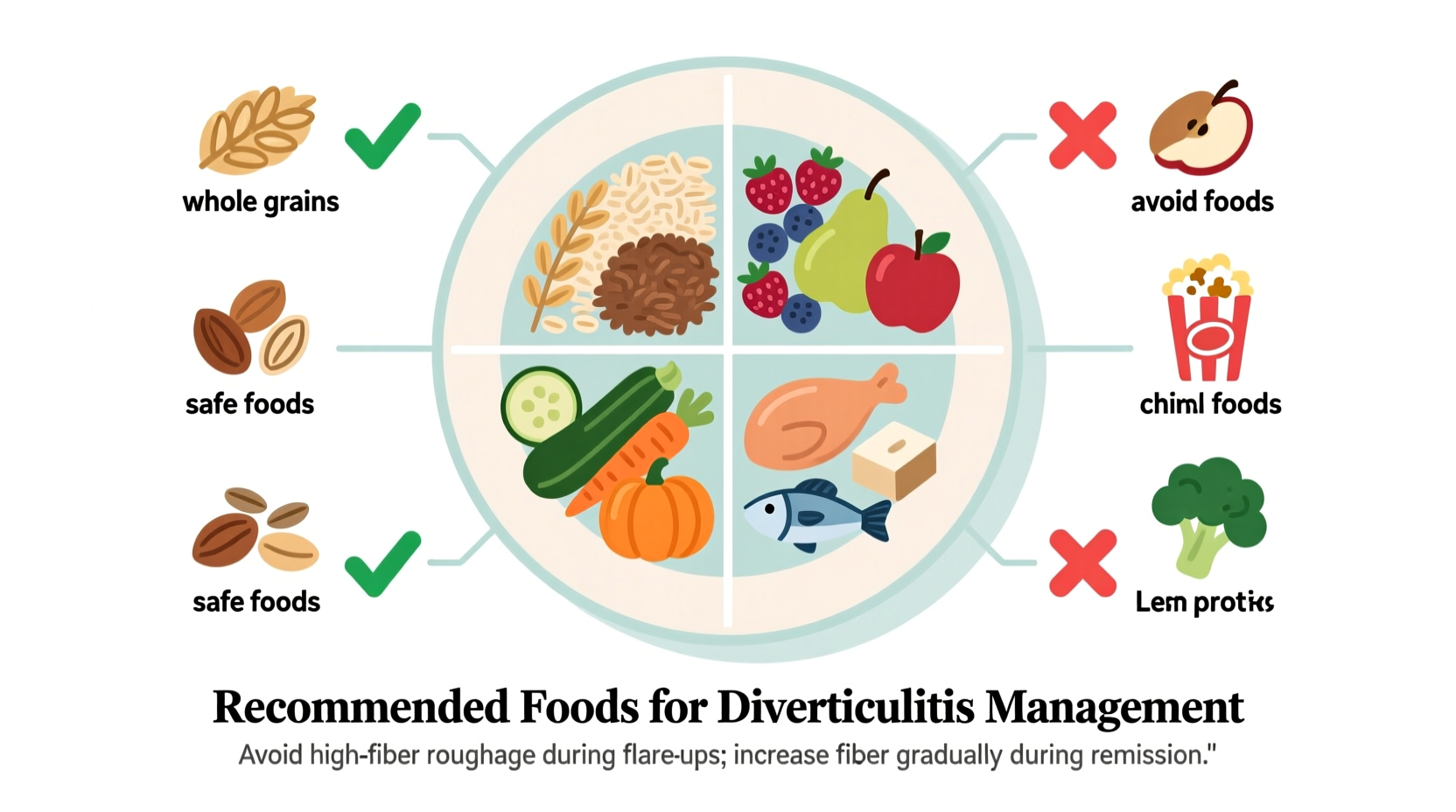During diverticulitis flare-ups, start with clear liquids then progress to low-fiber foods like white rice, eggs, and cooked vegetables. As symptoms improve, gradually introduce high-fiber foods including whole grains, fruits, and vegetables. Current guidelines no longer recommend avoiding nuts, seeds, or popcorn as previously thought.
When diverticulitis strikes, knowing exactly what to eat can mean the difference between a quick recovery and prolonged discomfort. As someone who's helped countless patients navigate this common digestive condition through evidence-based dietary strategies, I've seen how the right food choices at the right time significantly reduce recovery time and prevent future flare-ups.
Your Diverticulitis Diet Roadmap: From Flare-Up to Maintenance
If you're reading this during an active diverticulitis episode, you're probably experiencing abdominal pain, fever, and digestive distress. The good news? Your food choices right now can actively help you heal. Let's walk through exactly what to eat at each stage of recovery, based on the latest clinical guidelines from gastroenterologists and registered dietitians.
Phase 1: Acute Flare-Up (Days 1-3)
When symptoms hit their peak, your digestive system needs complete rest. During this critical window:
- Begin with a clear liquid diet for 24-48 hours
- Transition to full liquids as pain decreases
- Avoid all solid foods until fever subsides
Clear liquid options: Water, broth, apple juice, gelatin, herbal tea. These provide hydration without taxing your inflamed colon.
Full liquid options: Smooth nut butters (in small amounts), Greek yogurt, protein shakes, oatmeal (well-cooked), mashed potatoes. The National Institute of Diabetes and Digestive and Kidney Diseases (NIDDK) recommends these transitional foods as your system begins to heal.
Phase 2: Recovery (Days 4-7)
As pain decreases, gradually reintroduce low-fiber foods. This phase is crucial for preventing complications while allowing your colon to heal.
| Safe Foods | Foods to Avoid | Portion Guidance |
|---|---|---|
| White rice, pasta, bread | Whole grains | 1/2 cup cooked grains |
| Canned fruits without skins | Fresh berries, apples with skin | 1/4 cup portions |
| Cooked vegetables (carrots, green beans) | Raw vegetables, corn | 1/2 cup cooked |
| Eggs, lean meats, fish | Fried foods, spicy dishes | 3-4 oz portions |
The Evolution of Diverticulitis Dietary Recommendations
Understanding how medical thinking has evolved helps explain why current guidelines differ from what you might have heard in the past:
- 1950s-2000s: Strict avoidance of nuts, seeds, and popcorn believed necessary to prevent complications
- 2008: Harvard study of 47,000 men found no increased risk from nuts or popcorn
- 2018: American Gastroenterological Association formally updated guidelines, removing restrictions on seeds and nuts
- 2023: Current standard focuses on individual tolerance rather than blanket restrictions
This timeline matters because many outdated recommendations still circulate online. The current standard, supported by the American College of Gastroenterology, emphasizes that most people can safely consume nuts, seeds, and popcorn unless they personally notice these foods trigger symptoms.
Phase 3: Long-Term Maintenance
Once fully recovered (typically 2-4 weeks after symptoms resolve), gradually increase fiber to 25-30 grams daily. This is where many people make critical mistakes that lead to recurrence.
The fiber progression strategy:
- Start with 10-15g fiber daily during recovery phase
- Increase by 5g every 3-4 days
- Reach 25-30g daily over 2-3 weeks
- Spread fiber intake evenly across meals
A 2022 study published in the American Journal of Gastroenterology found patients who followed this gradual approach had 37% fewer recurrences than those who jumped straight to high-fiber diets.

Practical Daily Management Tips
Implementing these strategies makes the biggest difference in real-world success:
Hydration is non-negotiable: For every 5g of fiber, drink 8oz of water. Dehydration while increasing fiber causes more flare-ups than any other single factor.
Reading food labels: Look for "soluble fiber" content (oats, psyllium, fruits) which is gentler during recovery than insoluble fiber (wheat bran, vegetables).
Eating out safely: Request dressings/sauces on the side, choose grilled over fried options, and ask for steamed vegetables instead of salads during early recovery.
When to Consult Your Doctor Immediately
Dietary management works only when symptoms are mild. Seek medical attention if you experience:
- Fever above 100.4°F (38°C)
- Severe or worsening abdominal pain
- Inability to keep liquids down
- Blood in stool
These symptoms may indicate complications requiring antibiotics or hospitalization. The Mayo Clinic emphasizes that proper medical treatment combined with appropriate dietary management yields the best outcomes.
Your Personalized Approach Matters Most
While general guidelines provide a framework, your individual tolerance determines your optimal diet. Keep a food and symptom journal for 2-4 weeks after recovery to identify your personal triggers. The Academy of Nutrition and Dietetics recommends this approach because diverticulitis triggers vary significantly between individuals.
Remember: What works for one person might not work for you. The goal isn't perfection but finding your personal balance between nutrition, comfort, and prevention.











 浙公网安备
33010002000092号
浙公网安备
33010002000092号 浙B2-20120091-4
浙B2-20120091-4